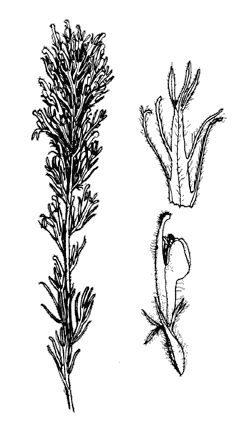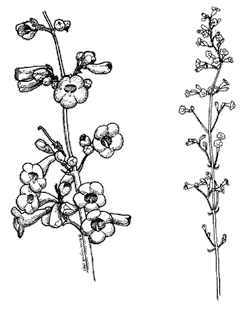Scrophulariaceae(snapdragon family)
This family numbers 4500 species worldwide and includes snapdragons, penstemons, monkeyflowers, owl clover, and Texas ranger. They are a northern (temperate) component of the Sonoran Desert flora; most species respond to the winter rains.
Castilleja exserta [Orthocarpus purpurascens]
English name: purple owl-clover
Spanish name: escobita
(whisk-broom)
 |
Description
Owl-clover is a winter annual 6 to 8 inches (15-20 cm) tall. The small, snapdragon-like flowers are nearly hidden among the large, bright pink bracts that tip the stems.
Range
It grows in grassland and deserts from central California to northwestern Mexico.
Notes
All members of this genus are partial parasites, usually on the roots of composite shrubs. Owl-clover is one of our showiest spring wildflowers, occurring in huge, dense stands after wet winters. There are no known ethnobotanical uses, but the O’odham admire it for its beauty.
Penstemon parryi
English name: Parry penstemon
Spanish name: jarritos (little jars)
 |
Description
Parry penstemon is an annual or short-lived perennial with a rosette of basal leaves and flowering stems to 4 feet (1.2 m) tall. Snapdragon-like flowers (but with open throats) are bright pink to purple-pink.
Range
It occurs mostly in the desert from central Arizona to southern Sonora.
Notes
This is one of the earliest of the showy wildflowers; it’s usually in bloom by March 1 in Arizona Upland. Seeds germinate in the fall and flower the following spring. If summers are not too dry, the plants may survive for 3 or 4 years. This is the only desert penstemon that reseeds reliably in desert gardens.










